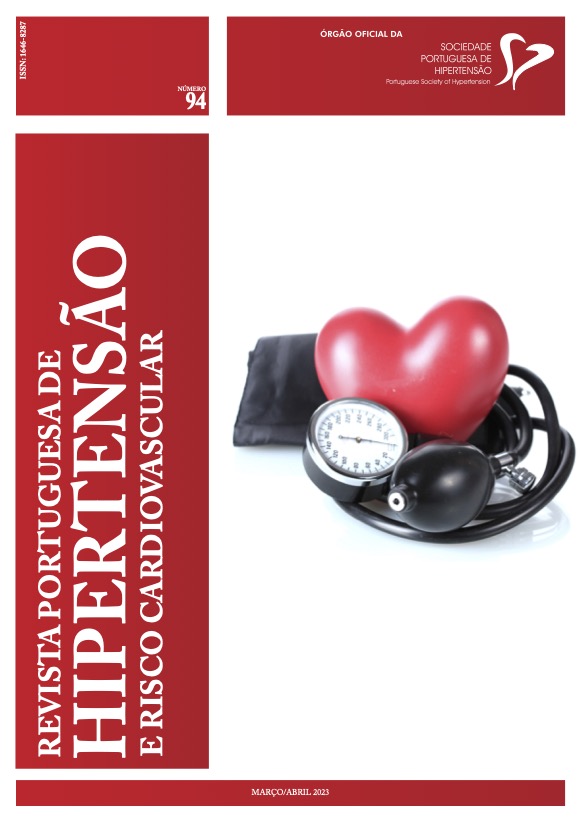Silent Changes In Blood Pressure In Sickle Cell Anemia - Clinical Case Of A Severe Acute Complication
DOI:
https://doi.org/10.58043/rphrc.77Keywords:
sickle cell disease, hypertension, pediatrics, reversible posterior leukoencephalopathy syndromeAbstract
Recent studies indicate that high blood pressure is not uncommon in sickle cell disease patients, largely manifested by masked hypertension, and the specific endothelial lesions that occur in this disease may put them at greater risk of acute and chronic cardiovascular events. Posterior reversible encephalopathy syndrome is a potentially serious acute neurological manifestation of an hypertensive crisis and this patients are at greater risk of developing it.
Eleven-year-old female patient with sickle cell disease diagnosed in the 1st year of life. She had no previous changes in blood pressure values, but she was medicated with enalapril for left ventricular hypertrophy and mitral and tricuspid insufficiency. She was hospitalized for sepsis complicated by osteoarticular necrosis, severe infection and difficult in pain control. On the 16th day of hospitalization, she presented headache, inadequate speech, sustained masticatory movements, vague and undirected eyes gaze, no response to simple commands and de novo blood pressure values higher than the 99th percentile. The cranioencephalic magnetic resonance was compatible with posterior reversible leukoencephalopathy syndrome. Analgesic, hypertensive, and antiepileptic therapy was started, with progressive clinical improvement and recovery with no neurological sequelae.
One of the acute complications of hypertension may be manifested by posterior reversible encephalopathy syndrome, which should be interpreted carefully in sickle cell disease patients, because other acute neurologic conditions may occur in this disease and have different management. The treatment of this syndrome must encompass a rapid withdrawal of the trigger factor, control of the blood pressure values using antihypertensive agents and cessation of the seizure activity with antiepileptic drugs. When early treated, it seems to be fully reversible. On the other hand, when diagnosis and treatment are delayed, it may be associated with severe complications.
It is essential to monitor blood pressure in patients with sickle cell disease, avoiding the early development of target organ damages and acute and chronic cardiovascular complications, which patients with sickle-cell disease are at greater risk of developing.
Downloads
References
Naik RP,Derebail VK.The Spectrum of Sickle Hemo- globin-Related Nephropathy: From Sickle Cell Disease to Sickle Trait. Expert Rev Hematol. 2017;10(12):1087- 1094. doi: 10.1080/17474086.2017.1395279.
Neill TA. Reversible posterior leukoencephalopa- thy syndrome. [retrieved June 2021]. UpToDate. 2021. Available at: https://www.uptodate.com/con- tents/reversible-posterior-leukoencephalopathy- syndrome?search=Reversible posterior leukoencepha- lopathy syndrome&source=search_result&selectedTitl e=1~150&usage_type=default&display_rank=1.
Moodalbail DG, Falkner B, Keith SW, Mathias RS, Araya CE, Zaritsky JJ. Ambulatory hyperten- sion in a pediatric cohort of sickle cell disease. J Am Soc Hypertens. 2018;12(7):542-550. doi: 10.1016/j.jash.2018.04.005.
Treadwell MJ.Transition from pediatric to adult care: Sickle cell disease. [retrieved June 2021]. UpToDate. 2021. Available at: https://www.uptodate.com/con- tents/transition-from-pediatric-to-adult-care-sickle- cell-disease?search=Transition from pediatric to adult care: Sickle cell disease&source=search_result&selecte dTitle=1~150&usage_type=default&display_rank=1.
Tchaou M, Modruz N, Agoda-Koussema LK, Mi- chelot A, Naffa S, Jeudy V, et al. Two Unusual As- pects of Posterior Reversible Encephalopathy Syn- drome Mimicking Primary and Secondary Brain Tumor Lesions. Case Rep Radiol. 2015;456217. doi: 10.1155/2015/456217.
Magray MA, Mufti GN, Banday SB. Posterior Re- versible Encephalopathy Syndrome after Augmenta- tion Cystoplasty in a Child with Neurogenic Bladder. J Indian Assoc Pediatr Surg. 2018;23(3):158-160. doi: 10.4103/jiaps.JIAPS_204_17.
Lerma EV, Vichinsky EP. Sickle cell disease effects on the kidney. [retrieved June 2021]. UpToDate. 2021. Available at: https://www.uptodate.com/contents/sick- le-cell-disease-effects-on-the-kidney?search=Renal manifestationsofsicklecelldisease&source=search_resul t&selectedTitle=1~150&usage_type=default&display_ rank=1.
Hanafy E, Alshareef D, Osman S, Al Jabri A, Nazim F, Mahmoud G. Posterior reversible encephalopathy syndrome secondary to asymptomatic poststreptococ- cal glomerulonephritis in a child with sickle cell ane- mia: a case report. J Med Case Rep. 2018;12(1):24. doi: 10.1186/s13256-017-1559-x.
Walia HS, Grumbine FL, Palejwala NV, Sawhney GK, Risner DS, Walia SS. A Very Rapid Visual Recov- ery of Posterior Reversible Encephalopathy Syndrome. J Clin Imaging Sci. 2011;1:36. doi: 10.4103/2156- 7514.82341.
Vichinsky EP.Overview of the clinical manifestations of sickle cell disease. [retrieved June 2021]. UpToDate. 2021. Available at: https://www.uptodate.com/con- tents/overview-of-the-clinical-manifestations-of-sick- le-cell-disease?search=Overview of the clinical mani- festations of sickle cell disease&source=search_result &selectedTitle=1~150&usage_type=default&display_ rank=1.
Downloads
Published
How to Cite
Issue
Section
License
Copyright (c) 2023 Filipa Urbano, Ana Ventura, Anabela Ferrão, Carla Simão

This work is licensed under a Creative Commons Attribution 4.0 International License.




